By Bus & Rail
Tough audit sparks reforms
July 17, 2014
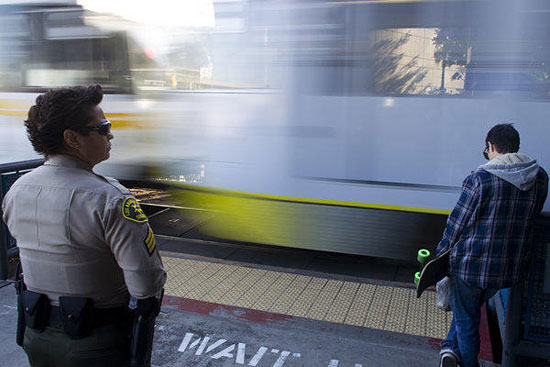
A sheriff's deputy keeps an eye on goings-on at a Blue Line platform last fall. Photo/Los Angeles Times
A hard-hitting new audit says the L.A. County Sheriff’s Department has failed to live up to its multimillion dollar contract to police the Metro system, while the transit agency itself has done a poor job of monitoring the sheriff’s performance.
The audit was commissioned by Metro’s Board of Directors last year and performed by the firm Bazilio Cobb Associates, with a team including members of the Bratton Group, LLC. The May 27 report faulted the sheriff on a number of fronts, including lack of a community-policing plan for the nation’s third-largest bus and rail system, perennial staff vacancies, tardy responses to citizen complaints and inadequate records to support its billings.
Overall, the audit determined that both the Sheriff’s Department and Metro had significant improvements to make.
“We found that Metro needs to substantially strengthen and enhance its oversight of LASD contract performance,” it said. “We found LASD has not met many of the targets for performance metrics, including crime reduction, continuity of staff, and fare enforcement saturation and activity rates.”
The audit was presented to Metro’s System Safety and Operations Committee on Thursday. CEO Art Leahy told the panel that new management at the sheriff’s department now has “an intense focus on delivering the goods here. There’s no finger-pointing, there’s no excuses. They can do better and Metro can do better.”
Sheriff’s Cmdr. Michael Claus, while disagreeing with a few of the report’s conclusions, said most of its 50 findings were on target.
“The bottom line is: we didn’t do what we should have done,” Claus said in an interview. “No one likes to be told they’re not doing a good job, but they were right in a lot of areas.”
Claus, who became Metro’s head of security in January, said reforms already are underway. Those include upgrading the Transit Services Bureau into a full-fledged sheriff’s division with its own chief, to whom Claus now reports. That move, effective July 1, will give structure to the team and enable it to advocate more effectively for staff resources, Claus said. It also may be a morale-booster for deputies assigned to the transit beat, which the audit said has been considered undesirable or even punitive by some within the department.
“By making it its own division, probably 20 people have removed their transfer requests,” Claus said.
The audit comes as the sheriff’s Metro contract—by far the department’s largest—is up for renewal. The new contract will likely be worth more than $400 million over five years, the report said. The department currently is working under a $42 million six-month contract extension that expires on Dec. 31.
The audit covered five years beginning July 1, 2009 and found lots of room for improvement. Among its findings:
- Critical information—such as up-to-date blueprints and maps of station layouts—needed in the event of an attack on Metro’s transit system has not been shared with key tactical response units within the sheriff’s department. (Claus, a former SWAT officer and commander, said an effort to provide up-to-date, digitized information is underway, but insisted that the sheriff’s units in question already are familiar with Metro facilities.)
- The transit security operation has operated with high levels of vacancies and too often sends in substitute staff without the necessary transit expertise.
- The department has double-billed for some supervisors’ time; billed Metro at the full rate even when managerial, supervisorial and support positions went vacant; failed to provide enough backup documentation of time being worked; and in fiscal 2011 submitted bills of $59,368 above the maximum amount allowed under the contract.
- Customer complaints against deputies often are not processed on time, and deputies with multiple complaints against them usually aren’t routed into the department’s “performance mentoring program.” (Claus said a backlog stretching to 2010 has now been eliminated.)
- Mobile phone validators used by deputies to check patrons’ TAP cards are technologically inadequate and can’t be used for basic crime-fighting tasks, such as looking for outstanding warrants when people are stopped for fare checks. Better fare-validation devices are being developed, the audit said, but other issues involving checking TAP cards remain unresolved—notably the question of whether that duty should be handled primarily by Metro’s own security staff rather than sworn deputies.
- Crime reporting and response time statistics are not being appropriately reported. (The department has switched, as recommended, to the FBI’s Uniform Crime Reporting standards, Claus said. He said the department disagrees, however, with a recommended change in reporting response times that would start the clock running when a Metro operator receives a call—not when it reaches the sheriff’s department.)
The audit also said the sheriff’s transit security team was not engaged enough in making quality of life improvements in Metro facilities.
But, according to the sheriff’s department, that finding overlooks a notable recent success story.
“Deputies have made tremendous strides in cleaning up Union Station; examining and solving delicate homeless rights issues, solving quality of life issues, making the area a cleaner, hazard-free experience for patrons, etc.,” according to the official response to the audit from interim Sheriff John Scott. “More is to be done, but to say that great strides have not been obtained would simply not be reflective of the current status.”
As for Metro, the audit found that the agency has failed to set forth adequate contractual requirements for the sheriff’s department, and has been lax about keeping tabs on the requirements that are in place.
In a response to the audit, Duane Martin, the agency’s deputy executive officer for project management, wrote that his department is asking for more staff to provide better contract oversight. He said Metro also will seek to modify its existing contract to enable it to seek damages if the sheriff doesn’t live up to specified performance targets—including crime reduction and continuity of staffing—and will write that into the next contract as well.
Beyond the audit, Metro CEO Leahy said he also has ordered a peer review of his agency’s security services by the American Public Transportation Association. Those findings will be examined, along with the audit, by Metro’s board this fall.
Posted 7/17/14
Looking at Valley rail and beyond
July 17, 2014
A push to transform the popular Orange Line busway into the San Fernando Valley’s first light rail line may also jumpstart a broader examination of what the next chapter in L.A. County transportation could look like.
Metro’s Board of Directors next week will consider a motion to study options for improving the Orange Line, along with the possibility of connecting the Orange, Red and Gold Lines with Burbank and Bob Hope Airport. But that motion—by L.A. City Councilmember Paul Krekorian, Mayor Eric Garcetti, Glendale City Councilman Ara Najarian, Supervisor Zev Yaroslavsky and Duarte Mayor John Fasana—has now prompted a related push to create a roadmap to update Metro’s long term plans for the entire county.
Taken together, both concepts, if approved by the agency’s full board, could begin to give shape to the list of projects that might be included in potential new transit sales tax measure that could be on the 2016 ballot.
“It has to be part of a transparent, inclusive and innovative long range planning process from which a new sales tax ballot initiative should emerge,” said Santa Monica Mayor Pam O’Connor, who proposed the countywide amendment along with Lakewood Councilmember Diane Dubois and Supervisor Don Knabe at Metro’s Planning and Programming Committee meeting this week.
The current push to investigate upgrades to the Orange Line comes after Governor Jerry Brown recently signed into law a bill permitting ground-level rail in the busway’s corridor.
Some have argued that other, less costly improvements are the best way to improve the Orange Line—which is carrying nearly twice the people originally projected and has been reaching capacity during rush hours.
But Coby King, board chairman of the Valley Industry and Commerce Association, the primary backer of the new state legislation, said converting the bus line to rail is the best way to serve the Valley’s 1.77 million residents.
“The problem is that the Orange Line has become a victim of its own success,” King said. “We believe that rail is the answer. Let’s do the objective study and let the chips fall where they will and we can make a decision on the facts—and a certain amount of equity.”
King added that Measure R, the original 2008 half-cent sales tax measure to fund transit projects, brought 36 miles of new rail to other parts of the county but left the Valley with none. For the region to support a new tax measure, additional rail lines for the Valley would have to be a part of the equation, he said.
At the committee meeting, Metro CEO Art Leahy weighed in on the big picture as well as the specific concerns of Valley residents.
“Without a doubt the number of projects is going to exceed the amount of money a measure is going to generate, so at some point we are going to have to sit down with the subregions and talk turkey about what goes in,” Leahy said.
Posted 7/17/14
The whammy on Wilshire
June 12, 2014
As the 405 Project starts to move out of the limelight as L.A.’s most groused-about long-running transportation project, attention is shifting to a new construction hot zone: Wilshire Boulevard.
With a litany of high-visibility public and private projects in the works or on the horizon, the legendary boulevard is gearing up for a years-long building boom, particularly in the Miracle Mile.
“Seriously, if it’s not one thing, it’s another,” said Ginny Brideau, a consultant with The Robert Group who is handling community outreach for one of the projects, a new lane dedicated to buses at rush hour and available to all drivers at other times.
As part of that project, crews already are building special lanes and resurfacing Wilshire from Western Avenue to San Vicente Boulevard—work that entails closing lanes, detouring sidewalk traffic and putting up temporary no-parking signs.
Later this month, things start heating up miles to the west, as work begins on another bus rapid transit segment near the V.A. in West Los Angeles—close to where the 405 Project has been a high-profile challenge for nearly five years. Construction of the short (less than ½ mile long) bus lane on Wilshire between Federal Avenue and Bonsall Avenue will bring lane closures for the next seven months. That includes a period in which traffic will be detoured away from ramps connecting Wilshire to the Bonsall underpass. (Details are here.)
The Wilshire bus project is intended to create a faster-moving 12.5-mile corridor for rush hour riders between MacArthur Park and the Santa Monica border, and to improve traffic for everyone by tempting more people to ditch their cars and hop aboard public transit.
But it’s just the first leg of what promises to be an epic journey on Wilshire. Here’s a brief taste of what’s happening now, or coming down the road soon:
- The project to extend the Purple Line subway from Western to La Cienega Boulevard is currently busy with utility relocation, including after-hours jackhammering and saw-cutting. The action is expected to intensify in the months ahead when demolition begins on the first of 17 buildings set to come down to create staging areas for the project. Actual subway construction, including pile-drilling and station excavation, will start next year, according to a timetable presented at a recent community meeting. A more immediate impact: next week’s closure and relocation of Metro’s Wilshire/LaBrea customer service center.
- At the same time, private developers have started work on the Desmond on Wilshire, a new 7-story apartment structure in the Miracle Mile that’s expected to be finished by next summer.
- Then there’s the new Academy of Motion Pictures Arts & Sciences museum, designed by Renzo Piano, to be built on the old May Co. site at Wilshire and Fairfax Avenue and heading for a 2017 debut.
- Right next door, the Los Angeles County Museum of Art is developing plans of its own for a new building by Pritzker Prize-winning architect Peter Zumthor to open in 2023, replacing several aging buildings on the museum campus.
In the scheme of things, the Wilshire bus rapid transit project is expected to wrap up relatively quickly, by next year.
“I’m thrilled that it’s going in,” said James O’Sullivan, president of the Miracle Mile Residential Association. “It’s made a mess out of Wilshire, and 8th Street has become a jungle at times. But it’s short term.”
There’s a much longer road ahead for the subway extension.
“Our issue all along has simply been: we don’t understand how we can do nine years of this, 24/7,” O’Sullivan said. “We know it’s coming. We know it’s going to go in. We have lots of questions.”
Complicating matters is the sometimes confusing welter of agencies with a piece of the action: the county is building the bus lane from Federal to Bonsall, the city is constructing the rest of the bus rapid transit project, Metro is in charge of building the subway and is funding much of the bus lane work, utility companies are out in force moving lines in support of a variety of projects, and the Los Angeles Police Commission is responsible for canvassing residents and businesses when a project needs an exemption from work hours requirements under the city’s noise ordinance.
In the midst of all that, consultant Brideau said she understands how people feel when they experience problems: “You don’t care who it is, you just want it to stop.”
She recently came to the rescue of a toy store owner who arrived one day to find that a contractor had unceremoniously installed a portable restroom right in front of her business. Brideau also has been known to remove no-parking signs left up too long after bus lane work has concluded.
Calls to the bus rapid transit project’s hotline—(213) 922-2500—are promptly returned, Brideau said, and so are messages left on its Facebook page.
As for the subway, project director Dennis Mori acknowledges there’s a lot going on, but said the results—new transportation and cultural facilities that will provide a broad public benefit—will be worth it in the end.
“We look forward to the opportunity of integrating our plans and construction activity with the other projects,” Mori said. While there’s lots of coordination ahead, he said, the agency has been there before on other successful endeavors.
“We’ve had those experiences in the past,” he said, pointing to collaborative work between Metro’s Red Line subway team and the group building the Hollywood & Highland center. “We had very busy schedules and both parties worked very closely together.”
Posted 6/11/14
Students fare well on Metro
May 22, 2014
When Metro’s board voted to raise fares today, students got a hall pass.
Metro’s Board of Directors froze student fares at their current rates, while directing staff to explore creating a diversion program to keep fare-evading young people out of the criminal justice system. The action came in response to a motion by Supervisors Mark Ridley-Thomas, Zev Yaroslavsky and Don Knabe, and Mayor Eric Garcetti.
The decision to spare students came after a marathon hearing at which nearly 140 people testified against the fare hikes. Overall, Metro’s base fare will increase by 25 cents to $1.75 this September, while weekly passes will rise from $20 to $25 and monthly passes from $75 to $100. At the same time, the board also voted for the first time to bring free transfers, good for two hours of travel, to the Los Angeles transit system, doing away with the long-running practice of charging $1.50 for each leg of a rider’s journey. The board voted 12-1 to approve the changes, with Supervisor Gloria Molina casting the lone dissenting vote.
The move to focus on students calls attention to one of Metro’s key constituencies.
Metro spends about $10 million a year to subsidize fares for K-12, college and vocational students, agency spokesperson Paul Gonzales said. That translates to big savings for individual riders over time—for example, student monthly passes are just $24 instead of the normal $75. Those discounts are critical for students like Samantha Healy, 15, a sophomore at the Ramon C. Cortines School of Visual and Performing Arts.
“Our families have a lot to pay for already because when you’re a student there’s a lot of stuff you have to do,” Healy said. “It gets expensive.”
Another student interviewed at the Civic Center subway station, India Barrett, said Metro often is the only way she and her friends can get around.
“I think it’s a good idea for fares to stay low because students take the train all the time,” Barrett said. “Parents don’t have the time to take kids everywhere they need to go.”
In April, more than 2 million rides were taken by students during the week, accounting for 10% of Metro’s weekday ridership.
And there’s still room for more to jump aboard. According to a 2009 survey, 51% of L.A. County students aged 5 through 15 usually took private vehicles to school—many doing so even when the trip was a half mile or less. That’s 7% above the national average, said Jessica Meaney, the Southern California policy director for the organization Safe Routes to Schools. Meaney said Thursday’s action represents a step toward getting more families to make use of the transit system.
“Removing barriers for students will increase ridership and help Metro achieve its regional goals,” Meaney said.
For students like 15-year-old Trecey Dory, it all comes down to basic economics.
“Increasing fares? Yeah, that would suck,” Dory said. “It’s hard enough for me to scrape up the $24.”
Tululla Steele, 15, said she hasn’t applied for student fares because she hasn’t gotten an identification card from her school yet. She questioned the logic of raising fares in the first place.
“It is public transportation, after all,” Steele said. “It’s supposed to be affordable.”
Beyond the economic issue, some have complained that citations for fare evasion unnecessarily criminalize young people. The motion approved by Metro’s Board of Directors seeks to change that.
“It pushes to decriminalize a system which gives an adult a ticket and a kid a record,” Mayor Garcetti said.
In approving the motion, the board directed the agency’s staff to report back in September on creating a diversion program, which could include things such as online education and community service in lieu of court appearances and heavy fines. The motion also suggests looking into possible legislative fixes; most adult violations were diverted to Metro’s administrative Transit Court in early 2012, but the L.A. County Superior Court requires juveniles to appear because of state law, said Duane Martin, Metro’s executive officer in charge of transit security.
Out of 110,073 total fare evasion tickets issued in 2013, 10,073 of them went to minors, about half between the hours of 3 p.m. and 6 p.m.
Posted 5/22/14
A quicker ride over the hill
March 27, 2014
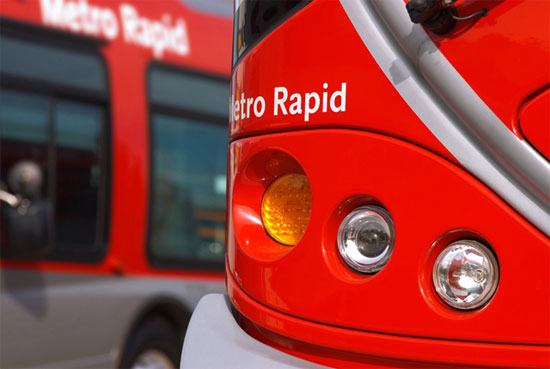
For the first time in two decades, Metro buses could be running on the 405 through the Sepulveda Pass.
When the $1 billion-plus 405 Project wraps up later this year, its new carpool lane will be the star attraction—and maybe not just for cars.
Metro is considering running a new express bus between the San Fernando Valley and the Westside, taking advantage of the new lane. It would be the first time in two decades that Metro buses have driven the 405 Freeway through the Sepulveda Pass.
The buses would offer a nonstop ride to UCLA and Westwood from Victory Boulevard and the Orange Line. They would also make stops along Van Nuys Boulevard to Nordhoff Street as far north as Panorama City.
Funding still must be identified, but, acting on a motion by Supervisor and Metro Director Zev Yaroslavsky, the agency’s board today directed staff to get moving on the studies, tests and analyses that would be required to launch the proposed new Line 588.
That includes looking at one potential major concern: whether the agency’s buses have the horsepower to maintain high speeds uphill in the fast lane. “The last thing anyone wants is to slow down traffic,” said Jon Hillmer, Metro’s director of service councils.
Express service in the carpool lanes was first suggested last fall by two Local Service Councils—appointed bodies that provide Metro with a regional perspective during the annual process of adjusting bus routes.
Metro’s staff then looked into the proposal, and the line has been taking shape ever since. Earlier this month, the Westside/Central and San Fernando Valley councils held public hearings on service changes and both recommended adding the express service, Hillmer said.
The public was supportive, too, with about 20 people speaking in favor of Line 588 at the Valley meeting.
“That usually doesn’t happen unless we are cancelling bus lines,” Hillmer said. “There is very broad support for this express bus.”
When Phase 2 of the Expo Line opens in 2016, the bus line would have another important connection; it would extend south to meet the light rail line, creating a new pathway to Santa Monica and, heading in the other direction, to downtown L.A.
Before any of that can happen, however, the bus line must be funded. Even after fares are collected, it will take at least $1.65 million to operate it—something the board could authorize as soon as April, when all of the proposed service changes come before it.
In the meantime, for Metro’s operations staff, the approval of Yaroslavsky’s motion means that Line 588 can be further studied and fine-tuned.
Because of increasing congestion, Metro’s buses haven’t taken the 405 freeway through the Sepulveda Pass for 20 years, Hillmer said. Metro Line 761 currently goes through the pass, but it travels on Sepulveda Boulevard, making several stops. (The Los Angeles Department of Transportation does have a bus that runs on the freeway, however—the Commuter Express Line 574, from Encino to LAX.)
Better transit connections between the Valley and the Westside have been on L.A.’s wish list for years. In 2008, voters approved $1 billion for a much larger undertaking that could include tunneling and rail, but that project is on hold as Metro seeks additional funding and project acceleration by partnering with private companies. In the meantime, Line 588 could start service as soon as the 405 lanes open this summer, Hillmer said.
Initially, the bus would be limited to weekday rush hours. But if enough people ride, Hillmer said, it could be expanded to include weekend service—opening a path to new destinations for entertainment, food and shopping for residents on both sides of the hill.
“They are huge economic engines,” Hillmer said of the Valley and Westside. “This opens up all kinds of wonderful opportunities.”
Posted 3/27/14
Lights out for Metro e-cigs
March 26, 2014
You’re not allowed to eat your lunch, sip a soda or fire up a smoke on Metro trains and buses—and now vaping, that popular and highly controversial new pastime, has joined the no-no list, too.
Metro’s Board of Directors approved a change in the agency’s Customer Code of Conduct to make it clear that vaping or lighting up cigarettes of any type—including e-cigarettes—is not permitted in its facilities, vehicles or within 20 feet of entrances. Vapers could be kicked off the train or bus and fined $75—although they may be able to reduce that or avoid it altogether by taking online “transit school” or performing community service.
A staff report, by Julie Chang, the principal hearing officer in Metro’s transit court, said the action is part of a national trend.
“Our research indicates that municipalities locally and across the nation are all restricting e-cigarettes in a manner consistent with other smoking activities, such as cigarettes and cigars,” the report said.
Those include the Los Angeles City Council, which recently voted to ban vaping in bars, nightclubs and restaurants. Restrictions are also in place in cities including Boston, Chicago and New York.
Metro decided to tackle the issue after members of the public and law enforcement agencies asked for a clarification of the agency’s e-cigarette policy. But even before an official code change was enacted, some riders have assumed that onboard vaping is verboten—and are calling out e-smokers accordingly.
“You can’t do that on the train,” one Red Line passenger angrily told another as the man exhaled vapor from his e-cigarette on a recent morning.
The vaping passenger insisted he was allowed to light up, but stopped smoking his e-cigarette anyway. The man who confronted him left the train before the encounter could escalate.
But the broader controversy around e-cigarettes will not be extinguished that quickly.
Companies marketing the new e-cigarettes, along with boutiques peddling vaping equipment and an array of tempting-sounding flavors of liquid inserts, contend that their product is safe—and, unlike regular cigarettes, poses no second-hand smoke threat.
Public health experts and elected officials are wary, however, and say more research is needed. They’re also concerned about the potential of a new generation getting hooked on nicotine—decades after America’s smoking wars seemed settled.
Poison control officials are also alarmed by the rapid spread of vaping, pointing to a growing number of incidents in which young children have fallen ill after accidentally ingesting nicotine-infused “e-liquids” in kid-friendly flavors like bubble gum and chocolate.
In addition, a recent study casts doubt on the claim, popular among e-cigarette advocates, that vaping is an effective way to quit smoking.
E-cigarettes and specialized pipes called vape pens use a battery-charged heating element to create vapor from liquids laced with nicotine or other chemicals. The U.S. Food and Drug Administration, which does not currently regulate the product except for e-cigs marketed for “therapeutic purposes,” says that consumers should be cautious until the risks are more fully known.
Posted 3/27/14
Fare hike with a freebie
March 19, 2014
As Metro considers changing its fare structure, proposed price increases have captured attention—and generated controversy—as a March 29 public hearing approaches.
But embedded in the plans under consideration is an element that promises to be a bargain for some riders: free transfers.
Metro estimates that half of its customers transfer at least once during their bus and rail trips. Under the current fare structure, individual ticket-buyers must pay an initial fare to ride and then pay again every time they change lines. For those paying the full base fare, that means choosing to pay $1.50 for each leg of their journey, or purchasing a day pass currently priced at $5.
Under the fare restructuring proposals now under consideration by Metro’s Board of Directors, passengers would pay once to board and then would be able to transfer for free within the system as frequently as they wish for 90 minutes. It’s a way of addressing the growth of a system in which bus and rail transfers are increasingly essential to getting around—and Metro is calculating that giving away transfers will eventually benefit the bottom line by enticing more people to try, and stay with, public transit.
Those customers will, however, be paying more to board in the first place if the plan goes through. And those purchasing Metro passes would, in many cases, be hit with even sharper price increases than single-trip buyers.
If Metro’s board approves the proposed changes at its May 22 meeting, the cost of a regular Metro base fare would go from $1.50 to $1.75 starting in September, rising to $2 in fiscal 2018 and to $2.25 in fiscal 2021. Day passes would go from $5 now to $7 in September, $8 in 2018 and $9 in 2021. Other passes, including discounted cards for seniors, students and the disabled, would go up as well. Details are here.
A second proposal under consideration would also raise fare and pass prices, but would include off-peak and peak pricing options to give riders a break if they don’t travel at rush hour.
A major critic of the fare hike plan is the Bus Riders Union, which contends that the proposed fare hike would hurt the poor and violate the civil rights of minorities. Since 1995, Metro has raised fares three times, with the base fare increasing 25 cents to its current $1.50 in 2010, although seniors, students and the disabled were exempted from that increase.
On a late morning this week at the 7th Street/Metro station in downtown L.A., several commuters said they view the proposed fare hikes as a reasonable trade-off for free transfers. But others said they’d rather see different kinds of improvements.
For example, Ural Garrett, a freelance writer and photographer, said that in addition to free transfers, the agency should offer discounted fares for round trips.
Bus security is a big issue for Chigo Ikeme, a 19-year-old student at the Fashion Institute of Design & Merchandising who makes multiple transfers to get to her job at the Citadel Outlets. She said she would willingly pay more if the funds went directly to boosting security on buses—but otherwise is against any fare increases.
“I feel that they shouldn’t raise the fares,” she said. “Especially for a student, it’s hard to have to pay extra.”
Ikeme and others said they’d like to see Metro’s free transfer program expanded to allow them free passage on buses run by other local transit lines. People who buy Metro’s $85-a-month EZ Pass can do that now, and under the fare restructuring plan, all regular monthly passes would be merged into the program by 2018. By then, the monthly price would be $120—but daily, weekly and discounted passes for students, seniors and the disabled would not be included.
Nevertheless, Reagan Cook, who’s studying for his master’s degree in international relations at USC, said he considers Metro a good deal.
“I come from Toronto, Canada, and I still think the Metro service is incredibly cheap in L.A., relatively speaking,” Cook said. “I understand that they have to increase it eventually.”
Metro officials say the increases are needed to help it offset an operating deficit that will be $36 million by 2016 and is projected to grow in a decade to $225 million. And they add that Metro fares remain a bargain compared to those in place elsewhere, with San Francisco Muni customers paying $2 a ride, New York subway passengers $2.50 and Chicagoans $2 for buses and $2.25 for trains. In addition, all of those agencies allow free transfers, according to Metro spokesman Rick Jager.
“We have absolutely the lowest fares in the country,” Jager said. “If we don’t do something now…we’re looking at huge deficits in coming years.”
Jager said it’s also a chance to give more bang for the buck to cash customers, who pay $1.50 per trip compared to about 70 cents for pass-holders, who enjoy the discount that comes with buying their transit trips in bulk, so to speak.
Cash customers, Jager said, “are really putting more money into the fare-box than the pass-holder…We want to equalize the system to try to be fair to all of our riders.”
In any case, Metro riders are getting a heavily subsidized ride—and will likely continue to do so.
In a report to Metro’s board in January, the agency’s staff said that its “fare box recovery ratio”—the portion of revenue it receives from the traveling public—is just 26%, the lowest of any major U.S. transit agency. The fare increases are intended to bring that to 33% by 2021.
The public hearing will take place at 9:30 a.m. on March 29 at Metro headquarters in downtown Los Angeles. Those who’d like to comment in writing can send an email to [email protected] or a letter to: Los Angeles County Metropolitan Transportation Authority, One Gateway Plaza, Los Angeles, CA 90012-2932 Attention: Michele Jackson.
Posted 3/19/14
Looming train shortage at Metro
March 12, 2014
As two Los Angeles light rail lines race toward completion, there’s trouble ahead on the tracks. Unless train car production can be significantly accelerated, there won’t be enough vehicles to serve both new lines—Phase 2 of the Expo Line to Santa Monica and the Gold Line Foothill Extension to Azusa—if they open as scheduled in late 2015 and early 2016 respectively.
Metro is so concerned about the problem that it’s dispatching a delegation to the manufacturer’s headquarters in Japan later this month in hopes of finding a way to speed up production—a tall order for a company that the agency acknowledges is on track with the aggressive schedule mutually agreed to under its contract.
So, with a likely initial shortfall of about 50 train cars, the issue presents some tough decisions for Metro, all of which are likely to be unpopular with the traveling public. It could delay the new lines’ openings, operate them with shorter, more crowded trains, offer less frequent service, or redeploy cars from elsewhere in the system, thus spreading the pain more broadly.
The shortage is expected to be most severe in the first months of operation for the two new extensions, with steady improvements coming as new rail cars arrive throughout 2016. But even the prospect of a relatively short-lived disruption has been enough to strain the relationship between Metro, which will operate the lines, and the two construction authorities charged with successfully completing the projects.
Samantha Bricker, chief operating officer for the Exposition Light Rail Construction Authority, expects Expo Phase 2 to be ready for testing in the summer of 2015, which would make it possible for the line—running from Culver City to Santa Monica— to serve the public as early as December, 2015. But she’s worried that the train car shortage could impede that schedule and disappoint passengers looking forward to jumping aboard the westernmost phase of a light rail line that’s already attracting large numbers of riders.
“If these projects are done on time and there are no trains there, the public is going to go nuts,” Bricker predicted.
Metro’s Gold Line Foothill Extension, running from Pasadena to Azusa, is expected to open just two months later. Habib Balian, chief executive officer of the Foothill Construction Authority, said he, too, is worried that his line’s opening will be delayed or marred by diminished service in the early months.
“It’s going to sit there and cobwebs are going to grow until Metro starts service, or they are going to put wimpy service on all the rail lines,” Balian said, referring to the possibility of importing rail cars from elsewhere in the system.
The roots of the problem go back to 2010, when a previous manufacturer, AnsaldoBreda Inc., failed to meet the specifications for an earlier order of Gold Line cars, according to Richard Hunt, who manages Metro’s rail car procurements.
Given the time crunch, Metro’s chief executive officer, Art Leahy, urged Board members to act quickly and, in April, 2012, after a competitive bidding process, the Board awarded a new contract to another company, Kinkisharyo International, LLC. After Kinkisharyo landed the contract, it relocated its U.S. headquarters from Boston to El Segundo and is currently building a facility in Palmdale where the final assembly of the Metro rail cars will take place.
Metro officials say they are confident that Kinkisharyo can deliver, but due to the time lost after parting ways with AnsaldoBreda, the process is now a year behind schedule.
No easy solutions are apparent, but Metro is brainstorming fixes and contingency plans, said Brian Boudreau, an executive officer who oversees major capital projects. All options remain on the table.
On March 27, Metro Board Chair Diane DuBois and Pam O’Connor, chair of the Expo Authority and a member of Metro’s Board of Directors, will join Hunt on a delegation to Kinkisharyo’s headquarters in Osaka, Japan to check on the progress and see if anything else can be done.
Hunt said the agency already has submitted a formal request to Kinkisharyo to speed delivery, but acknowledged that the prospects of that are slim.
Kinkisharyo’s president, Teiji Tani, agreed.
“The schedule that Kinkisharyo International and Metro agreed to was and is very aggressive,” Tani said in an email. “Given the challenges we have been facing, it’s unlikely that the schedule can be accelerated on the initial 78-car order.”
The current contract calls for delivery of 78 light rail vehicles at a price of $299 million, with options for additional cars for Metro’s expanding light rail network that could bring the total value of the contract to $890 million. The agreement includes what Hunt called an “unprecedented” delivery schedule—about twice as fast as normal. Kinkisharyo agreed to deliver the first 78 cars at a rate of 4 per month, beginning in September, 2015. The final installment wouldn’t arrive until January 20, 2017, about a year after the rail lines are expected to open.
Metro’s chief of operations, Debra Johnson, demurred on the question of how big the impact on transit riders could be, but said that “all options have to be assessed.”
“Here we are, stewards of the taxpayers, and we are going to do our due diligence to make sure they are least-impacted,” Johnson said.
Metro’s Board of Directors is scheduled to get a status update on the situation in April, including feedback from the delegation to Japan as well as contingency plans for running the lines without all the cars.
In the meantime, Kinkisharyo officials say they are keeping things moving as fast as possible.
“We are finalizing design, setting up our assembly plant in Palmdale and starting to produce the initial two cars, also known as test cars,” Tani said. “We’ll soon start hiring 100 additional employees for that plant.”
Posted 3/12/14
Metro’s hardest seat to get
February 13, 2014
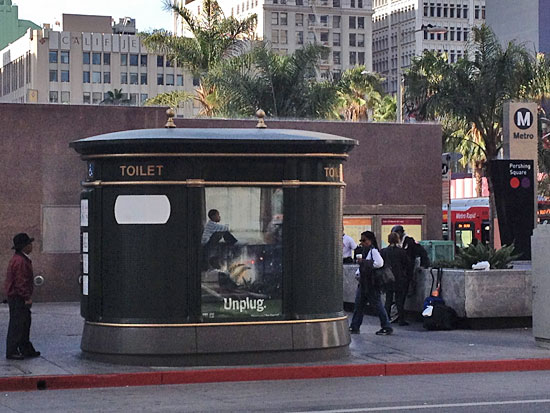
Despite a city-owned public toilet, Metro gets complaints of public urination at Pershing Square station.
As the saying goes, “When you gotta go, you gotta go.” That’s true whether you’re in a restaurant, a concert hall or riding a subway. But, despite public demand, installing restrooms at Metro stations is no easy business, according to the transportation agency, which recently undertook a study of the issue.
“We want to ensure that our customers have a great riding experience and have resources when a need arises, but there are a lot of elements that have to be factored in,” says Debra Johnson, Metro’s interim chief operating officer.
Although the agency has been grappling with the issue of public restrooms for years, Metro’s Board of Directors ordered a new look in November after residents near the Pierce College Station of the Orange Line busway in the San Fernando Valley complained that some riders were urinating in public. Among other things, Metro installed a video camera and monitored the area for 30 days, but couldn’t corroborate those complaints.
At the same time, the agency also was asked to take a look at the potential need for publicly-accessible restrooms at subway, light rail and bus rapid transit line stations throughout the system. The bottom line, according to a report that will be presented to the board later this month: Increasing the number of restrooms would not only be costly but could create crime problems unless security is enhanced at each location.
Currently, Metro maintains public toilet facilities at Union Station, the El Monte Bus Terminal and the Harbor/Gateway Transit Center—transportation “hubs” where staffers are present at all times. According to employee observations, restrooms in the busy Union Station were used consistently throughout the day. At the El Monte facility, five or fewer customers lined up during peak hours to use the free-standing automated public toilet, with less use at the Harbor/Gateway center.
The report notes that Metro employee restrooms are in place at Red Line subway stations but are opened to the public only in emergencies, as determined by Metro personnel. Generally, the report said, “customers are informed no public toilets are available,” even though it’s not uncommon for Red Line riders at the large 7th Street station to ask about the availability of public restrooms.
The agency, in its report, acknowledged the unpleasant realities that confront customers at some stations.
“Metro’s custodial staff report on-going issues with public urination and defecation at several of the rail stations as well as inside many of the station elevators,” the report said, adding that “other areas of public urination include the top side of subway station entrances such as Pershing Square, where loitering is common.”
But the agency pointed to the complexities of opening new restrooms with a cautionary tale of what happened when The W Hotel, located above the Hollywood and Vine Red Line station, agreed to provide a street-level public toilet as part of their contract with Metro.
According to Metro, the facility “became a magnet for the area’s homeless population which impacted the use by Metro’s customers. While open, the hotel developer was expending an average of $250 per day on paper products and had to replace three sinks, three mirrors and five toilet seats due to damage.” The restroom was labeled a public nuisance and was shuttered less than 4 months after its opening.
Johnson, Metro’s interim operations chief, notes that these kinds of problems are not limited to Metro operations. “It’s something that plagues us in today’s society considering the amount of people who don’t have access to facilities,” she said. “You could be walking around a city street and step around a puddle of urine. Collectively, I think there is an issue that needs to be addressed holistically.”
There’s also the price to consider. According to her department’s report, individual hard-wall toilets cost up to $700,000 to install and require regular stocking, maintenance and cleaning. In December, Robin Blair, the agency’s planning director, estimated that it would cost $70 million annually to maintain restrooms at every station. The agency estimates that the free-standing automatic public toilets would cost about $600,000 for two units, plus considerable custodial costs.
Then there are the public safety issues that come with adding restrooms to the system, thus creating a venue for illegal activity. “If you go anywhere in the world where people have tried this,” Blair said, “all of your problems are in the restrooms—crime, muggings, shooting up—all sorts of human degradation.”
“It’s up to the Board [of Directors] to decide what direction to take,” Johnson said. “For staff, our first and foremost mission is to ensure a safe environment for the riding public.”
No rider, of course, would argue with that goal. But a good number of them, like Renee Briddle, 38, who commutes 2 hours from Long Beach through downtown Los Angeles on the Blue and Red lines, think the status quo stinks.
Briddle was standing next to a small pool of urine the other day in a Civic Center station elevator. “It smells like that all the time,” she said, adding that such conditions are not uncommon, as Metro itself admits. One time, Briddle confided, she herself had an accident during one of her long commutes. “We need bathrooms,” she said, before hurrying on her way.
Posted 2/13/14




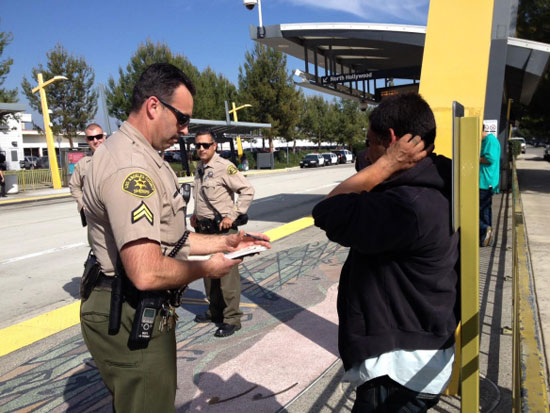

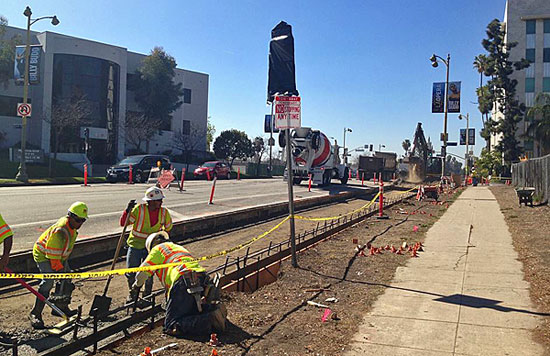
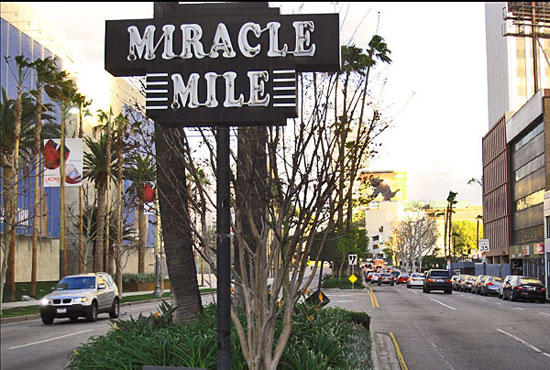
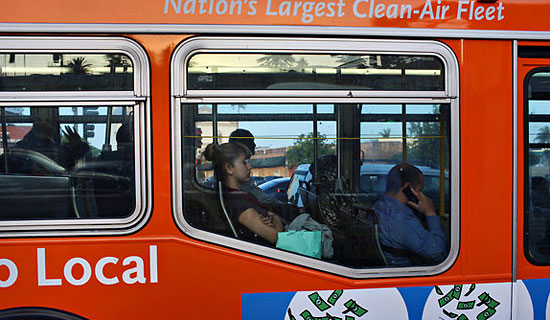
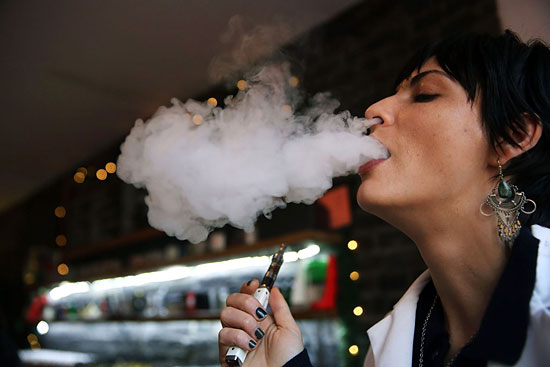
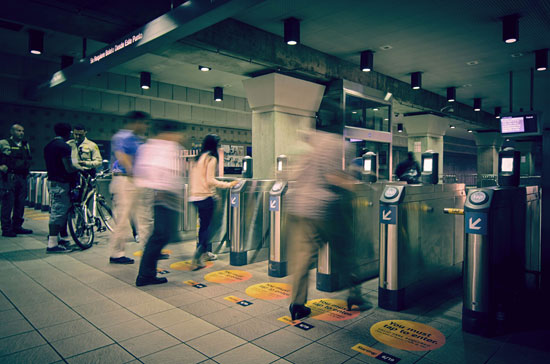
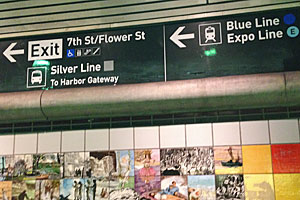
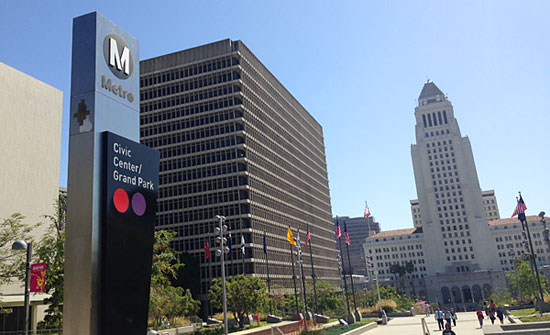
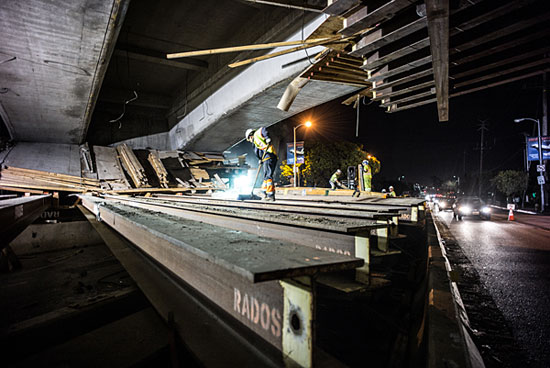
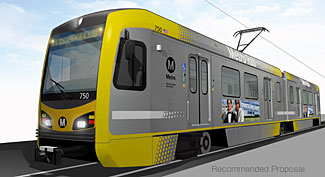
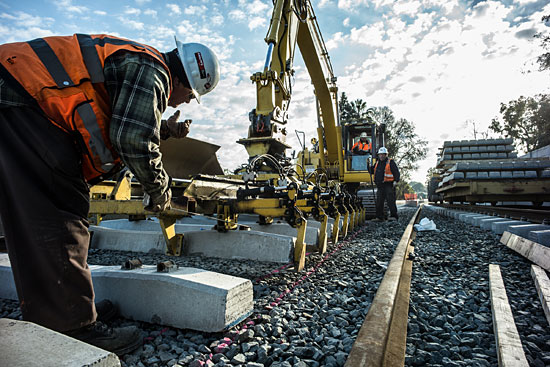







 405 bridge work causes a stink
405 bridge work causes a stink

